
Archaeology of Manila Galleon Seaports and Early Maritime Globalization
Springer Verlag, Singapore
978-981-329-250-5 (ISBN)
Written by archaeologists and cultural historians from America, Mexico, Japan, the Philippines, Mainland China, Hong Kong and Taiwan, it presents the latest investigations and research on the galleon-affiliated seaports, including Acapulco and San Blas in Mexico, Guam, Manila in Philippines, Yuegang (Crescent Harbor), Xiamen (Amoy), Keelung and Macao in China, Nagasaki in Japan. This joint research sheds new light on the history of navigation and maritime trade between galleon-affiliated harbors; the origin, production, transport and trade of the galleon cargo; social cultural exchange along the new Maritime Silk Road in the pan-Pacific region; and the history of maritime globalization in last 500 years. It offers a new perspective on maritime archaeology and traces the different stages of the galleon trade and affiliated maritime history, including "Yuegang Outbound", "Manila Entrepotting" and "Bound for Acapulco", presenting a panoramagram of Spanish pan-Pacific trade and early maritime globalization.
Chunming Wu ( B.A. and M.A. in Archaeology and PH.D. in Chinese History from Xiamen University) is currently a researcher at Xiamen University’s Center for Maritime Archaeology. Dr. Wu’s interests are in the field of maritime archaeology, and the prehistoric culture and early aboriginal ethno- history of southeast China and Southeast Asia. He was awarded a visiting scholarship by the American Council of Learned Society & Luce Foundation at the University of Hawaii at Manoa, and Harvard Yenching Institute, Harvard University. He has published 6 monographs: Archaeological Research of the History and Cultures of Prehistoric Aboriginals in Southeast China (1999), Archaeological Research of Capital of Min-Yue Kingdom of Han Dynasty(1998), The Shipwreck Archaeology in Seas Surrounding China (2003), Maritime Archaeology (2007), The Maritime Cultural Interaction between Indigenous Yue and Austronesian (2012),The Archaeological and Historical Research on the Maritime Cultural Heritage (2016), and more than 150 academic papers. Roberto Junco Sanchez is an archaeological researcher and underwater archaeologist. He graduated from the National School of Anthropology and History in Mexico City with a master’s degree and a PhD, and also holds a diploma in Historical Archaeology from Leicester University. Since 2004, he has worked at the Underwater Archaeology department at the National Institute of Anthropology and History. He has worked on projects in Veracruz, Campeche and Guerrero, and surveyed in the Gulf of Mexico for the lost galleons of the 1631 fleet. He has written on diverse topics, such as historical archaeology, Chinese porcelain in Mexico, and the prehispanic rituality of Mexico. He is currently excavating the Manila Galleonsat the port of Acapulco. Miao Liu holds a PH.D. in Archaeology and Museology from Nankai University, and is an Associate Professor of Archaeology at the Department of History of Xiamen University. Her focus is maritime archaeology and the history of Chinese export ceramics. She was a Visiting Scholar at the Archaeology Institute of UCLA, USA. She has published numerous papers on the topic of maritime history, ceramic cultural history and southeast China’s Maritime Silk Road.
Introduction.- Panel 1 Yuegang Outbound:The Archaeology of Yuegang as the Key Transit Terminal for Manila Galleon.- 1 Bound for America:A Historical and Archaeological Investigation in Yuegang (crescent) Seaport as the Main Origin of Galleon Cargo.- 2 The Cultural Change of Kilns and Content of Export Ceramics on the Perspective of Development of Zhangzhou Seaports during the Ming and Qing Dynasties.- 3 The Investigation and Preliminary Analysis of Nan'ao No.I Shipwreck in Guangdong.- 4 A Historical Review on the Social-Cultural Impact of Yuegang-Manila Navigation on the Ancient Chinese Civilization.- Panel 2, Manila Entrepotting: Discovery of Galleon Trade Heritage at Manila, Macao, Keelung and Nagasaki.- 5 An Analysis on the Chinese Porcelain in the Manila Galleon Trades.- 6 Fujian and Hizen Ware: A 17th Century Evidence of the Manila Galleon Trade Found from Selected Archaeological Sites in the Philippines.- 7 Archaeological Researches on the Manila Galleon Wrecks in the Philippines.- 8 The Kraak Porcelains Discovered from Taiwan and Macao, and Their Relationship with the Manila Galleon Trade.- 9 Ceramics from Nagasaki: A Link to Manila Galleon Trade.- 10 Searching for the San Francisco (1609), a Manila Galleon Sunk off the Japanese Coast.- Panel 3, Bound for Acapulco: The Archaeology of the Pacific and America as the Galleon navigation record.- 11 The Development of Humåtak Village: the Life-Line of the Manila-Acapulco Galleon Trade.- 12 Clues to Internationalism in the Manila Galleon Wreck of the Late 1570s in Baja California.- 13 Archaeological Distribution of Chinese Porcelain in Mexico.- 14 The Chinese Porcelain from the Port of San Blas, Mexico.- 15 A Study of the Chinese Influence on Mexican Ceramics.
“The volume is illustrated with a large number of figures … making this work an excellent read for specialists in this area. ... The writing style is addressed to scholars and specialists, although the content could also be approached by general audiences with an interest in the subject. Furthermore, each chapter provides a thorough bibliography at the end which allows specialists and scholars a deeper approach to the specific topics presented in this volume.” (Jose L. Casabán,Journal of Maritime Archaeology, September 20, 2021)
| Erscheinungsdatum | 20.11.2020 |
|---|---|
| Reihe/Serie | The Archaeology of Asia-Pacific Navigation ; 2 |
| Zusatzinfo | 186 Illustrations, color; 13 Illustrations, black and white; XXXV, 268 p. 199 illus., 186 illus. in color. |
| Verlagsort | Singapore |
| Sprache | englisch |
| Maße | 155 x 235 mm |
| Themenwelt | Geisteswissenschaften ► Archäologie |
| Geschichte ► Allgemeine Geschichte ► Vor- und Frühgeschichte | |
| Geisteswissenschaften ► Geschichte ► Regional- / Ländergeschichte | |
| Sozialwissenschaften ► Ethnologie | |
| Sozialwissenschaften ► Soziologie | |
| ISBN-10 | 981-329-250-4 / 9813292504 |
| ISBN-13 | 978-981-329-250-5 / 9789813292505 |
| Zustand | Neuware |
| Haben Sie eine Frage zum Produkt? |
aus dem Bereich


